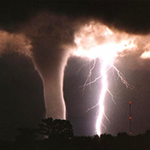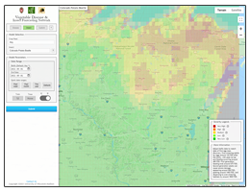Weather Data
Our weather page offers maps and data for temperature, precipitation, evapotranspiration, and solar insolation, derived from NOAA daily grids and satellite observations. We use Space Science's insolation model to derive estimates of solar radiation from satellite imagery. Combined with atmospheric data from Unidata's Internet Data Distribution project, this allows us to calculate reference evapotranspiration via the Priestley-Taylor equation to derive soil moisture and inform irrigation decisions. In addition, access archived National Weather Service hydrometeorological (HYD) reports, daily weather summaries throughout Wisconsin 1995-present. Our automated weather observation network (AWON) archive offers a record of hourly weather observations at Hancock and Arlington from 1985-2017.
Quick links:
- Maps and data: Weather | Precipitation | Evapotranspiration | Insolation
- National Weather Service HYD reports
- Automated Weather Observation Network (AWON) data archive (Note: stations are no longer active)
- Day-of-year calendar
- Wisconsin Environmental Mesonet (WiscoNet) - opens in new tab








